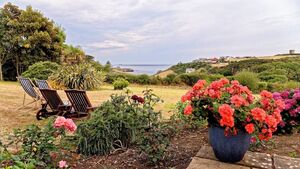Green Fingers: Oh I do like to be beside the seaside

Gardening with a sea view.
As soon as the first warm weather appears, we head en masse towards the sea, and it is usually after a long winter but it can happen at any time, especially after a dull, wet or cold spell.
There is something magical about the sea and when there, we can become hypnotised by just staring at the waves.
Many take it a little further by having their home near a coastal area. Having a sea view would be a big plus but as these locations are becoming rare and fetch a premium price the majority live within the vicinity of the sea and might have a marginal view at most but can smell the fresh air that a sea breeze brings.
It might not be that easy to have the ideal, which is a sea view and a sheltered garden. In most cases the view is uppermost in the mind, and the garden is an afterthought and then it is discovered that having a garden close to the sea can be difficult to achieve.
Coastal conditions can be wild and wet at times and with it perhaps salt laden winds, which burns up plants.
The best time to plant coastal gardens is in the spring when the plants will have a growing season to become more established before the winter storms.
There are, of course, plants that are reasonably resistant to all the sea can throw at them and these are the ones to concentrate on. It is also a good idea to check on what plants are growing in nearby gardens to get some ideas.
The simple solution is to plant on the sheltered side of an obstacle, such as a wall, house or plant a line of really tough plants to provide some protection for the garden.
The initial boundary planting can be further protected with a temporary mesh netting to help establish the plants quicker.
Tough plants to provide a screening and windbreak for the first line of defence include Elaeagnus ebbingei, Escallonia ‘Sea Breeze’, Fuschia riccartonii, Griselinia littoralis, Hebe elliptica, Sea Buckthorn, Olearia traversii, Rosa rugosa, Symphoricarpus and Ulex ‘Flore Pleno’.
For large sites with plenty of space, including farms, there are a number of suitable plants to consider and these include Acer pseudoplatanus, Populus alba, Quercus ilex, Cupressus macrocarpa and some of the pines (P.radiata, nigra and maritima).
I should concentrate the planting on the first line of defence as suggested above, even if it means a delay in starting with the interior until the initial plants are established. The one advantage is that once you have the protection, you can then grow a huge range of pretty and exotic plants as there is little or no frost near the coast to cause damage.
Suitable plants include Aucuba, Arbutus, Buddleia, Choisya, Cistus, Cotoneaster, Fuchsia (many types), Genista, Hypericum, Pittosporum, Rosmarinus.
Gardening near the coast can bring mixed feelings and results but if you follow the general rules and be a little patient you will succeed and have the best of both worlds, which can mean a sea view garden with many pretty flowers.
We have been experiencing less than ideal summer conditions and this, in conjunction with increased moisture levels, encourages diseases, especially in enclosed structures or spaces.
The organic way to reduce the risk or presence is to increase ventilation and where possible avoid overhead watering of plants like tomatoes, peppers and cucumbers. If you have any queries or comments you are welcome to share them with me on 051 384273 or orchardstowngardencentre@hotmail.com and if of general interest I will include it in a future article.






